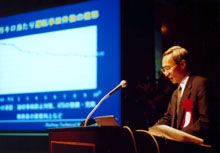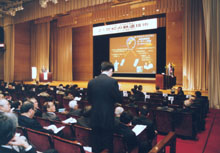 |  |
The Railway Technical Research Institute (RTRI) held the 14th annual lecture on railway technologies on November 15, 2001 at the Asahi Hall (in Tokyo), which was crowded almost to its full capacity with about 500 participants from JR group companies, private railways, municipal railways, railway-related companies, governmental organizations and universities.
The lecture, which was the first one of its kind that had been held in the 21st century, had a perspective view of changes in the social environment and railway technologies in the future under the theme "Railway Technologies in the 21st Century - To what extent can technologies create needs?" After the keynote address by Dr. Hitoshi Ieda, Professor, Faculty of Technology, University of Tokyo, on "Changes in the Social Environment and Technological Development - What railway technologies should be in the future," researchers in different fields made presentations on the basic safety technology, technologies for maintenance, information and environmental preservation and a vision of magnetically levitated railway in the future, as summarized below.
"Changes in the Social Environment and Technological Development - What railway technologies should be in the future" (Hitoshi IEDA, Dr. Eng., Professor, Graduate School of Engineering, University of Tokyo)
Dr. Ieda first quoted the development of new railway systems, such as Tokaido Shinkansen which Japan can boast to the world, and remarked that the realization of Shinkansen was significant not only because it had contributed to high-speed and high-frequency train operation, but also because it had generated additional needs for transport. As one of the reasons for the success of Shinkansen project, Dr. Ieda cited the fact that the mission of technological development to connect Tokyo and Osaka in three hours based on existing technologies was determined in a top-down manner. Dr. Ieda emphasized that systems should drastically be changed to create new needs in promoting technological development in the 21st century without being caught by stereotyped concepts, and specifically pointed out that engineers be positively involved in system changes; technologies in boundary areas be developed; and a balanced feeling was required for systems as a whole, against the changes in the social environment, as seen in the arrival of an aged society with fewer children and the needs to preserve the global environment and ensure the security of railway systems. Dr. Ikeda also remarked that, since railways, which are now enjoying a superior position to other transport facilities with respect to energy saving and space utilization efficiency, are gradually losing their superiority due to the popularization of low-pollution cars and the progress of ITS, it was important to discuss at this juncture how to promote technological development for railways in the future.
"Basic Technology to Support Safety" (Yasubumi SUZUKI, Dr. Eng., General Manager, Railway Dynamics Div., RTRI)
Dr. Suzuki analyzed the factors of railway accidents, such as crossing accidents, human errors and natural disasters including earthquakes, rainfall, snowfall, falling stones, and deterioration of the integrity of rolling stock, electric facilities, tracks and structures that compose a railway system, and reported the situation of technological development to prevent such accidents. Among others, Dr. Suzuki focused on the rail-wheel interaction in the field of basic technology, introduced the researches to analyze the dynamic interactive force between rolling stock, tracks and structures, derailment mechanism, adhesion between rail and wheel, and problems of rail damage due to contact fatigue, and pointed out the importance of cross-discipline research and development in boundary areas. To solve the problems related to the contact between rail and wheel, Dr. Suzuki stated that technologies should be developed in the future to positively control the conditions of contact surface.
"Development of Environmental Technologies - Past and Future" (Tatsuo MAEDA, Dr. Eng., General Manager, Environmental Engineering Div., RTRI)
One of the most important issues in the 21st century is how to address environmental problems. Dr. Maeda introduced the researches promoted by RTRI on the problems of low-frequency aerodynamic vibration and vibration of the ground, up-to-date research results on the noise emitted from railways which had been obtained from the tests on a large-scale wind tunnel of RTRI, and referred to new research themes including (1) those on the treatment of PCB, (2) effect of the electromagnetic field generated by railways on creatures, (3) environment monitoring to use vegetation and (4) methods to remove contaminants. As a means to solve the problems in the 21st century, Dr. Maeda pointed out the necessity to decrease the environmental loads by railways whose carbon dioxide emission source units are less than those of other transport facilities, thereby improving the convenience of travel and expanding the market share of railways.
"Further Improvement of Maintenance Technologies" (Takao NAGASE, Chief Researcher, Research and Development Promotion Div., RTRI)
Since the 21st century is predicted to be an age of maintenance when we should establish the methods to maintain and manage the various facilities generated by the mass-consumption society of the 20th century, Mr. Nagase introduced the results of research and development to decrease maintenance costs and research themes now being addressed at RTRI. Researches introduced by Mr. Nagase include (1) those to develop a non-pneumatic brake system to replace the existing air brake that requires a time-consuming maintenance service and non-disassembling gear diagnosis to use ferrography in the field of rolling stock; (2) image processing diagnosis and remote monitoring of tunnel lining cracks and diagnosis of the inside of concrete structures in the field of structure; (3) improvement of the efficiency to correct long-wave irregularities of long tracks by using an algorithm that controls the operation of multiple-tamper based on track inspection data and the method to suppress the settlement of ballast track in the field of track maintenance; and (4) extension of the life of trolley and messenger wires and a compact low-cost trolley wire wear measuring device in the field of power supply.
"Information Technology in the 21st Century" (Mikio TANAKA, Dr. Eng., Manager, Transport Information Technology Div., RTRI)
Utilization of high-level information technology is steadily advancing in the railway industry in the 21st century, or what is called an age of information technology. The rapidly changing social structure at present requires higher levels of "efficiency" and "flexibility." Dr. Tanaka emphasized that information technology be developed further as a means to respond to such needs, and introduced the (1) train control technologies such as the digital ATC system and balise-type train control device, (2) versatile and flexible transport planning based on precise prediction of transport demand, (3) a passenger guidance system for the weak, (4) the concept of cyber-rail which was introduced at the lecture last year, (5) support systems for facility management and inspection plans, and (6) training on simulation by the virtual reality technology.
"Maglev Technology in the 21st Century" (Tsutomu FURUKI, General Manager, Technical Management Div., Maglev Systems Development Department, RTRI)
In 2000 August, the superconducting maglev railway system now under development by RTRI was evaluated as "proven to be technologically feasible for commercialization" based on the results of the research and development and the tests on the Yamanashi Test Line for the past three years by the Commercialization Technology Evaluation Committee organized under the then Ministry of Transport. Running tests are scheduled for about five years starting in 2000 April to verify the reliability and durability of the system, develop technologies to reduce the system cost and improve the aerodynamic performance of rolling stock. Mr. Furuki introduced the present system composition, development of rolling stock, superconductive magnet and guideway construction and development of cycrogenic technology centering on that for superconductive magnets and power electronic technology for power converters. As future subjects, Mr. Furuki referred to the adoption of high-performance superconductive magnets and new power semiconductors, and proposed their application to super-high-speed public transport systems in the future.
 |  |